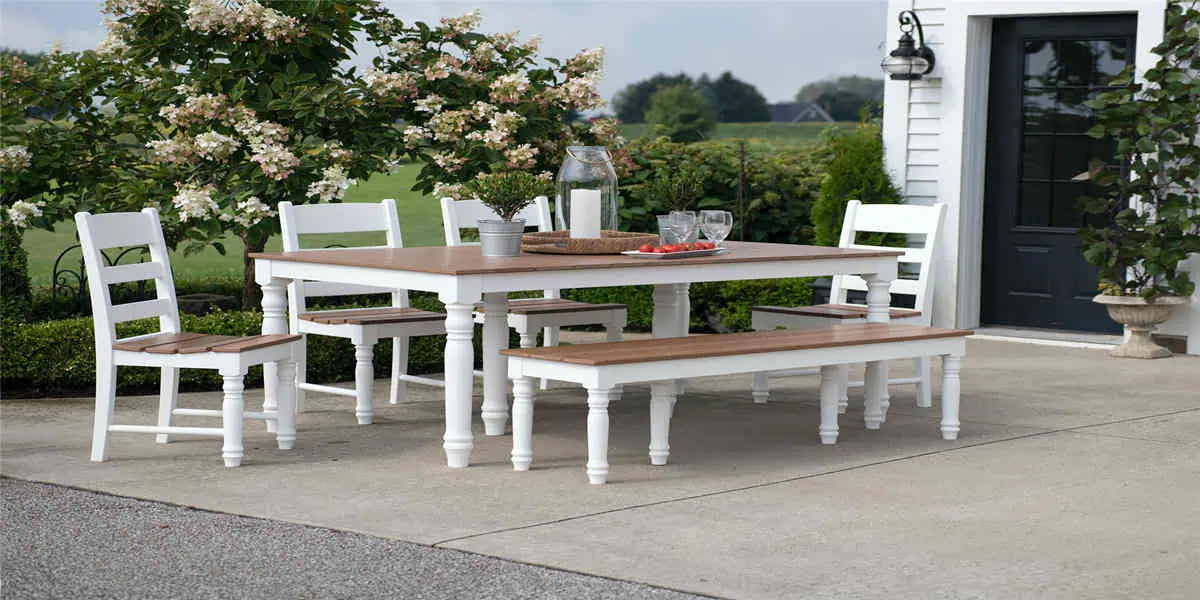If you want to add a space for outdoor dining and entertaining to your home, the patio is the best choice. Patios offer a great way to enjoy the outdoors while still having all the comforts of home. Making them the perfect place to relax, entertain and spend time with family and friends.
In short, it will not only make your outdoor space more attractive but will also add value to your home. If you want to DIY a patio but don't know where to start, here's your step-by-step tutorial.

(Patios and outdoor furniture)
Planning and preparing
Choosing the location of your patio
This is an important decision that can affect the function and enjoyment of your patio. Here are some factors to consider when choosing a location
- Sunlight. If you are looking to be able to enjoy the outdoors in full sunlight, then choose a location that receives direct sunlight.
- Views. Consider the view from your patio. If you have a beautiful garden or landscape, you may want to put your patio there to take advantage of those views.
- Access. Consider the ease of access to the patio. It should be easy to access from your house and any outdoor areas you want to connect. For example, the entrance to your backyard. Also, if your patio will be used primarily for outdoor dining, consider its proximity to the kitchen.
- Privacy. Decide how much privacy you want your patio to have. If you want a private space, choose a location that blocks the view of your neighbors or the street.

(Location of patio)
Decide the size of the patio
The size of the patio varies from a small 6x6 to a large 18x20. This will depend on the size of your home's backyard and the features needed. Do you host a lot of parties? Any thoughts on installing a fire pit? Is a couch or chairs more preferred? All these will affect the size of the patio. If your family is under 3 people then an 8x8 patio size is appropriate. If there are more than 3 people, it is best to choose a larger size than 10x10.
Tools and materials needed for DIY patio
Get these ready before you start patio construction.
- Tool: Shovel, wheelbarrow, measuring tape, level, hammer, trowel, mason's chisel, safety glasses, work gloves, garden hose.
- Materials: paving stones, gravel, sand, edging stones, landscape fabric, paver base, paver sand, polymeric sand, and landscape binder.
Building the patio
Mark out the layout
First select a flat, well-drained area. Measure and mark the area. Use a tape measure to mark the corners of the patio area. Then use stakes and string to mark the outline of the patio. After that use a level to make sure that the ground is level where you plan to build the patio. If it is uneven, you will need to make adjustments to ensure proper drainage.

(Shovel the turf)
Excavating the area
Start digging out the area inside the string line with a shovel to remove any sod or soil on it. The depth is 6-8 inches. Keep the ground level at all times while digging. Afterward, use a tamper or plate compactor to compact the soil at the bottom of the excavation. This will help prevent settling and ensure a stable base for the patio.

(Building a patio)
Laying the foundation
A landscape cloth was laid on the bottom, which was to prevent weeds from growing out. After that, a layer of gravel is poured in and compacted with a tamper.
Add a layer of sand and use a scraper to smooth it out. Start laying paving stones in one corner of the patio, using the rope line as a guide.
Gently tap the pavers with a rubber mallet to make sure they are level. Install the edging stones along the perimeter of the patio and use construction adhesive to hold them together. To secure the pavers in place and prevent them from shifting.
Once all pavers are in place, sweep polymeric sand over the surface of the patio. It is also best to use a broom to push it into the cracks between the pavers.
Finally, spray the deck with water to let the sand cure. The patio construction is also completed.

(Patio construction)
Patio maintenance
Clean the deck two to three times a year using mild soapy water. The sand between the pavers may erode or wash away over time. Please resand joints with fresh polymer sand. If any pavers are damaged, cracked, or crumbling, replace them as soon as possible to prevent danger.
Choosing Patio Furniture
Once the patio is built, it's time to choose patio furniture. Picking the right patio furniture can take your outdoor living to another level.
Types of furniture suitable for patios
Patio furniture in terms of material is divided into, rattan, wood, plastic, and aluminum. Rattan furniture today is mostly made of polyethylene, more durable, waterproof, and mothproof, ideal for outdoor use.
Wooden patio furniture is more expensive but has a natural look that adds a sense of tranquility to the outdoor space. Plastic furniture is inexpensive and lightweight, able to be moved at any time. There are more options for color and style, making it ideal for creating a stylish and versatile patio.
Aluminum furniture is strong and rust-resistant and lasts longer than plastic furniture. It is also far more resistant to water, oil, and structural strength than wood furniture. It is the most practical type of patio furniture.

(Patio furniture)
Tips for maintaining patio furniture
In the summer, it is best to avoid prolonged direct sunlight on patio furniture, regardless of the material. Plus when you meet the rainy season, it is almost impossible to remove the cushions from the furniture in time. So installing a canopy tent as a temporary shelter will make your life easier.
The canopy tent not only protects patio furniture but also allows you to enjoy the outdoors without being disturbed by the weather. The waterproof and UV-protective properties make it a star in all kinds of outdoor activities. Not only that, if your patio is not very private, a pop-up canopy with sides can also help you solve this trouble.
(Quictent canopy tent on the patio)
And maintaining patio furniture in winter needs to be determined by the material of the furniture.
Wooden furniture, for example, requires sanding and oiling in addition to dust cleaning. Aluminum furniture, on the other hand, needs to be checked for paint stripping, and if so, it needs to be filled with paint.
Rattan furniture and plastic furniture do not require much maintenance other than regular cleaning. Finally, if the patio furniture is not used for a long time, use a waterproof cover to protect them.
Conclusion
In short, a DIY patio is a great way to enjoy the outdoors while still having all the comforts of home. Choosing the right patio furniture can also make a big difference in your outdoor living experience. With these building and furniture suggestions, you can create the perfect outdoor space for relaxing, entertaining, and spending time with family and friends.









